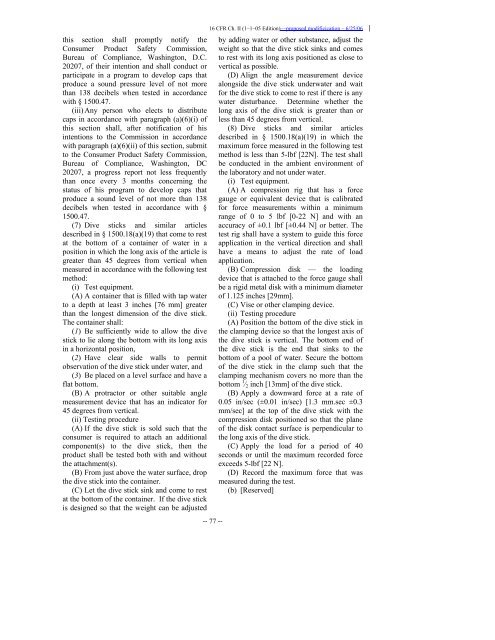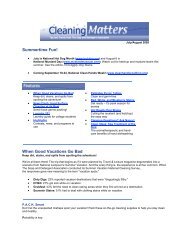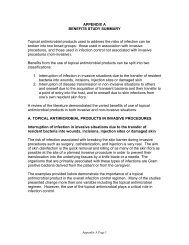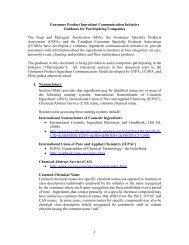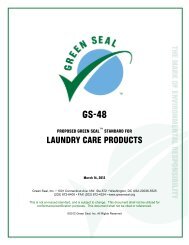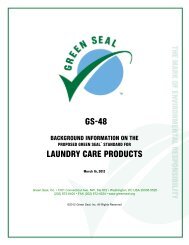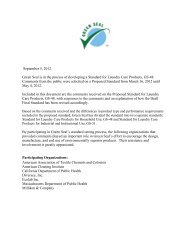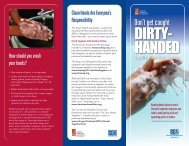subchapter c -- federal hazardous substances act regulations
subchapter c -- federal hazardous substances act regulations
subchapter c -- federal hazardous substances act regulations
Create successful ePaper yourself
Turn your PDF publications into a flip-book with our unique Google optimized e-Paper software.
this section shall promptly notify the<br />
Consumer Product Safety Commission,<br />
Bureau of Compliance, Washington, D.C.<br />
20207, of their intention and shall conduct or<br />
participate in a program to develop caps that<br />
produce a sound pressure level of not more<br />
than 138 decibels when tested in accordance<br />
with § 1500.47.<br />
(iii) Any person who elects to distribute<br />
caps in accordance with paragraph (a)(6)(i) of<br />
this section shall, after notification of his<br />
intentions to the Commission in accordance<br />
with paragraph (a)(6)(ii) of this section, submit<br />
to the Consumer Product Safety Commission,<br />
Bureau of Compliance, Washington, DC<br />
20207, a progress report not less frequently<br />
than once every 3 months concerning the<br />
status of his program to develop caps that<br />
produce a sound level of not more than 138<br />
decibels when tested in accordance with §<br />
1500.47.<br />
(7) Dive sticks and similar articles<br />
described in § 1500.18(a)(19) that come to rest<br />
at the bottom of a container of water in a<br />
position in which the long axis of the article is<br />
greater than 45 degrees from vertical when<br />
measured in accordance with the following test<br />
method:<br />
(i) Test equipment.<br />
(A) A container that is filled with tap water<br />
to a depth at least 3 inches [76 mm] greater<br />
than the longest dimension of the dive stick.<br />
The container shall:<br />
(1) Be sufficiently wide to allow the dive<br />
stick to lie along the bottom with its long axis<br />
in a horizontal position,<br />
(2) Have clear side walls to permit<br />
observation of the dive stick under water, and<br />
(3) Be placed on a level surface and have a<br />
flat bottom.<br />
(B) A protr<strong>act</strong>or or other suitable angle<br />
measurement device that has an indicator for<br />
45 degrees from vertical.<br />
(ii) Testing procedure<br />
(A) If the dive stick is sold such that the<br />
consumer is required to attach an additional<br />
component(s) to the dive stick, then the<br />
product shall be tested both with and without<br />
the attachment(s).<br />
(B) From just above the water surface, drop<br />
the dive stick into the container.<br />
(C) Let the dive stick sink and come to rest<br />
at the bottom of the container. If the dive stick<br />
is designed so that the weight can be adjusted<br />
16 CFR Ch. II (1–1–05 Edition)—proposed modificication – 6/25/06<br />
-- 77 --<br />
by adding water or other substance, adjust the<br />
weight so that the dive stick sinks and comes<br />
to rest with its long axis positioned as close to<br />
vertical as possible.<br />
(D) Align the angle measurement device<br />
alongside the dive stick underwater and wait<br />
for the dive stick to come to rest if there is any<br />
water disturbance. Determine whether the<br />
long axis of the dive stick is greater than or<br />
less than 45 degrees from vertical.<br />
(8) Dive sticks and similar articles<br />
described in § 1500.18(a)(19) in which the<br />
maximum force measured in the following test<br />
method is less than 5-lbf [22N]. The test shall<br />
be conducted in the ambient environment of<br />
the laboratory and not under water.<br />
(i) Test equipment.<br />
(A) A compression rig that has a force<br />
gauge or equivalent device that is calibrated<br />
for force measurements within a minimum<br />
range of 0 to 5 lbf [0-22 N] and with an<br />
accuracy of ±0.1 lbf [±0.44 N] or better. The<br />
test rig shall have a system to guide this force<br />
application in the vertical direction and shall<br />
have a means to adjust the rate of load<br />
application.<br />
(B) Compression disk — the loading<br />
device that is attached to the force gauge shall<br />
be a rigid metal disk with a minimum diameter<br />
of 1.125 inches [29mm].<br />
(C) Vise or other clamping device.<br />
(ii) Testing procedure<br />
(A) Position the bottom of the dive stick in<br />
the clamping device so that the longest axis of<br />
the dive stick is vertical. The bottom end of<br />
the dive stick is the end that sinks to the<br />
bottom of a pool of water. Secure the bottom<br />
of the dive stick in the clamp such that the<br />
clamping mechanism covers no more than the<br />
bottom 1 ⁄ 2 inch [13mm] of the dive stick.<br />
(B) Apply a downward force at a rate of<br />
0.05 in/sec (±0.01 in/sec) [1.3 mm.sec ±0.3<br />
mm/sec] at the top of the dive stick with the<br />
compression disk positioned so that the plane<br />
of the disk cont<strong>act</strong> surface is perpendicular to<br />
the long axis of the dive stick.<br />
(C) Apply the load for a period of 40<br />
seconds or until the maximum recorded force<br />
exceeds 5-lbf [22 N].<br />
(D) Record the maximum force that was<br />
measured during the test.<br />
(b) [Reserved]


